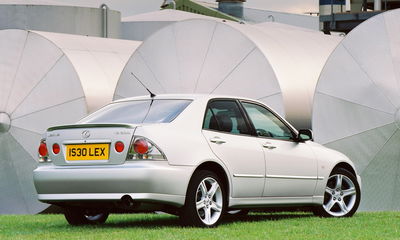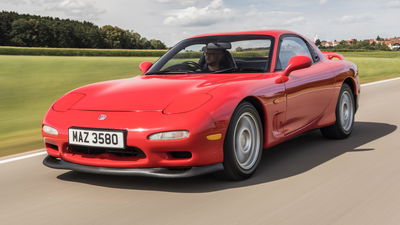7 Amazing VW Golfs That Aren’t GTIs

Few badge pairings in the world of cars carry as much weight as GTI within the vicinity of a Golf badge. Grand Touring Injection wasn’t the birth of the hot hatch, but it sure propelled the concept of a low-cost, practical performance car into the consciousness of the buying masses.
However, despite the majority of truly special Volkswagen Golfs carrying those fabled three letters, there’s been more than a handful of special entries into the model’s history. In light of the arrival of the new Mk8.5 Golf, we’ve picked out a few of our favourites.
Mk1 VW Golf

On paper, this isn’t the most inspired choice, but we can’t rattle on about special Volkswagen Golfs without the car that kicked the whole thing off.
Though the Volkswagen Beetle was still going strong by the 1970s, questions had been asked in the motoring media since the 1950s if Germany’s People’s Car was becoming dated. With more and more affordable, safer and efficient cars from its competitors flooding in, Volkswagen needed to act.
In 1969, a project named EA337 began development - leaning on front-wheel-drive tech and engines borrowed from Audi - eventually leading us to 1974 and the Volkswagen Type 17, or to us, the Golf.
By comparison to the Beetle, the Golf was space-age. It dropped an air-cooled engine for a water-cooled 1.1-litre four-pot with 50bhp and 56lb ft of torque sent to the front axle. Its boxy styling allowed for more interior space, and the Golf would go on to become one of Europe’s most commonly spotted cars.
VW Citi Golf

The Mk1 VW Golf didn’t have the longevity the Beetle was able to enjoy in Europe, being replaced with the Mk2 in 1983. However, in South Africa, it more than tripled that lifespan.
The Mk1 Golf went into local production in 1978 and was also initially replaced with the Mk2. However, it didn’t sell well due to a much higher cost than its predecessor, with Volkswagen SA leaving itself with a void to fill.
Step in the Citi Golf, introduced in 1984. Effectively, little changed compared with the regular Mk1 with the exception of ‘CITIGOLF’ emblazoned onto the rear and a couple of decals elsewhere. The 1.3-litre four-cylinder that had seen action towards the end of the Mk1’s life remained, albeit with some extra South African-specific modifications to give it some more power.
A Citigolf Sport with a 1.6-litre would follow in 1985, while a refresh came to bring its styling more in line with the Mk2 in 1998. Updates would continue to follow, including the ‘CTI’ which revived the Mk1 GTI’s engine in 1990, before the Citi Golf finally bowed out in 2009. Yes, 31 years after it had first gone on sale as the Mk1, leaving it with its own legacy as South Africa’s ‘People’s Car’.
Mk2 VW Golf G60 Rallye

Despite unexpectedly becoming the top class of rallying with the sudden demise of Group B in 1986, Group A rallying led to a whole new breed of mouth-watering homologation specials.
In 1989, Lancia was steamrolling the World Rally Championship with the Delta HF Integrale and then the upgraded 16v. Toyota posed its closest challenge with the new Celica ST165, while Mazda had moderate success with the 323 4WD.
Volkswagen wasn’t even close, however, lingering in ninth place in the manufacturers’ standings with the front-driven, naturally aspirated Golf GTI. It needed a replacement, and fast.
The result was the Golf Rallye, which became something of a parts bin special. An all-wheel-drive system from the Golf Syncro found a new home paired up with a 1.8-litre engine from the GTI. Albeit, now with a supercharger - and 18cc trimmed to ensure that it wouldn’t break the FIA’s 3.0-litre limit when a 1.7x ruling for forced-induction engines.
In road car trim, its performance wasn’t exactly what you’d call earth-shattering. It made 158bhp, a fair amount more than the standard GTI, but had to carry the additional heft of the all-wheel-drive system and the supercharger so really wasn’t any faster yet cost twice the price. At least it looked the part, separated from the GTI with its wider wheel arches and rectangular headlights.
Its rallying success wasn’t much better, either. A sole WRC campaign in 1990 saw VW finish 10th in the manufacturer’s standings with its best result a fifth placed finish at the Tour de Course.
Mk2 VW Golf Country

At the same time the Rallye would take to competing, the Mk2 had another special all-wheel-drive variant - albeit with a completely different purpose.
It only takes a look at the Golf Country to get an idea of what this car was about. It was jacked up by 21cm over the regular car, gained a bash plate at the front with bullbars and projectors, and a spare wheel at the back complete with unmissable ‘COUNTRY’ branding.
This wasn’t just an accessories package, either. The Golf Country’s body would be lifted from the regular production line and shipped off to Steyr-Daimler-Puch in Austria (you know, the same people building G-Wagens, now known as Magna-Steyr) for completion. Here, it’d also gain the GTI’s 1.8-litre engine.
Although definitely an oddity in 1983, you could easily argue the Country was well ahead of its time considering the crossover craze today. The Volkswagen Golf Alltrack, effectively a lifted GTD, is probably the closest we’ve come since but it doesn’t quite have the same charm.
Mk5 VW Golf R32

Long before the Volkswagen R became the boy racer car of choice, Volkswagen had gotten into the business of putting big VR6 engines into the hatch as a step up from the GTI. The first R32 came with the MkIV, but it’s the MkV that’s most fondly remembered.
Long before PPF filters came along to castrate the thrum of a VW Group engine, the 3.2-litre V6 made for easily the best-sounding hot hatch on the market - VTEC-heavy EP3 Type Rs and five-cylinder Focus STs be damned.
It offered proper performance, too, with 247bhp on tap 236lb ft of torque available from 2,500 rpm. 0-62mph was covered in 6.2 seconds when hooked up to DSG, although you could be a little bit slower and opt to row your own with a six-speed manual.
Well and truly separating the R32 from other hatches, as well as the GTI, was its 4Motion all-wheel drive system. It was nigh-on impossible to shirk its grip, even in wet, drab conditions - so it’s no wonder they became a relatively common sight in the UK.
Sadly, it would be the last time a VR6 would be deployed in a Golf, with the R following in 2009 and deploying the EA113 2.0-litre four-cylinder.
Mk7 VW Golf GTD

Is this cheating? It feels like cheating. After all, the Volkswagen Golf GTD was effectively a GTI chassis with a diesel shoehorned in place rather than a petrol.
Mind you, we’re not complaining about that fact. The GTD wasn’t new to the Golf by the time the Mk7 came around, having made an appearance on the first three iterations and then again for the Mk6, but arguably it’s the Mk7 that did it best.
All the GTI trimmings meant it had the proper hot hatch stuff - lower suspension, a stiffer chassis and even a limited-slip differential. Power came from a 2.0-litre TDI kicking out 181bhp - down on the GTI’s 217bhp - albeit with 22lb ft more torque than the GTI at 280lb ft.
In reality, it wasn’t any better to drive than the GTI and though offering more torque low-down, it was slower from a standstill - covering 0-60mph in 7.4 seconds to 62mph.
However, in 2013 before dieselgate had been uncovered and the world frowned upon oil burners, the everyday usability of the GTD made it a great compromise for those looking for a performance car without the associated high running costs. An official figure of 62.8mpg and a £160 tax bracket thanks to its relatively low CO2 emissions at its 2013 launch was just too hard to pass over for many.
Mk7 VW Golf R400

Arguably the best Volkswagen Golf is one that was never built. Yes, the GTI W12-50. Perhaps also the second-best falls under the same category. We’re talking about the Mk7 Volkswagen Golf R400, perhaps the biggest “What if?” in modern hot hatch mystery.
Back in 2014, a year on from the Mk7 Golf Rs introduction, Volkswagen took to the Beijing Motor Show to reveal the R400. It still used the 2.0-litre EA888, but ramped power up to 395 and 332lb ft of torque. Not unheard of by 2024 standards, but this is a time when the Mercedes A45 AMG was pumping out 335bhp, itself no mean feat at that point in time, and even the Mk8 Golf R is ‘only’ producing 315bhp. Better still, the concept had a six-speed manual gearbox.
You’d be able to tell the R400 apart from any regular R with its angry-looking front and rear bumpers, plus flashes of luminous yellow not too dissimilar to the green highlights on the Porsche 918 Spyder.
Volkswagen toyed with the idea of putting the R400 into production for a while before culling the project in 2016. The official line was that it’d be too expensive to be profitable, with an expected asking price of £50,000 at the time. Really, though, the ongoing dieselgate scandal meant VW had to cut costly projects like the R400 left, right and centre. Oh, what could’ve been.















Comments
No comments found.